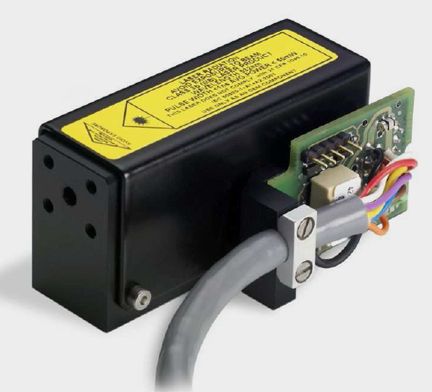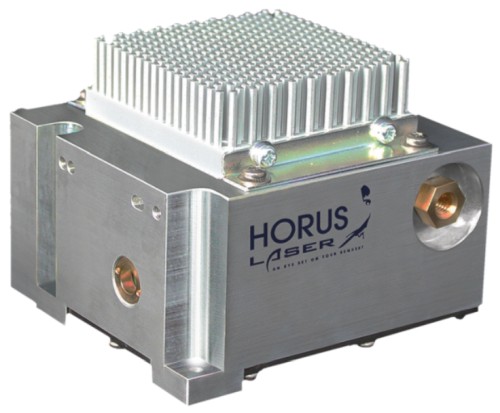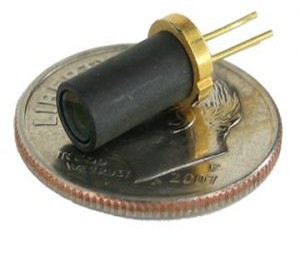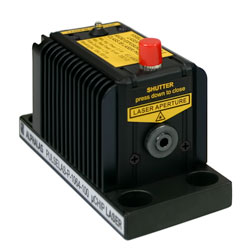microchip lasers (original) (raw)
Definition: solid-state lasers with a quasi-monolithic setup
Category:  laser devices and laser physics
laser devices and laser physics
- bulk lasers
- monolithic solid-state lasers
* nonplanar ring oscillators
* microchip lasers
- monolithic solid-state lasers
Related: solid-state lasersmonolithic solid-state lasers
Page views in 12 months: 948
DOI: 10.61835/tk5 Cite the article: BibTex BibLaTex plain textHTML Link to this page! LinkedIn
Content quality and neutrality are maintained according to our editorial policy.
📦 For purchasing microchip lasers, use the RP Photonics Buyer's Guide — an expert-curated directory for finding all relevant suppliers, which also offers advanced purchasing assistance.
Contents
Short Pulse Generation with Microchip Lasers
Microchip Lasers with Nonlinear Frequency Conversion
How is the laser beam stabilized in a microchip laser?
Why do microchip lasers often operate on a single frequency?
How can microchip lasers generate very short light pulses?
Can a microchip laser produce green or ultraviolet light?
What are common applications for microchip lasers?
Summary:
This article explains the technology of microchip lasers, which are compact, monolithic solid-state lasers. It covers their typical design, including gain media like Nd:YAG and the role of thermal lensing for mode formation.
Different operation modes are discussed, such as single-frequency operation and the generation of sub-nanosecond pulses via gain switching or Q-switching.
The article also details how nonlinear frequency conversion can be used to generate other wavelengths and lists numerous applications, from laser range finding to micromachining.
(This summary was generated with AI based on the article content and has been reviewed by the article’s author.)
What are Microchip Lasers?
Microchip lasers are alignment-free monolithic solid-state lasers [1] where the laser crystal (or glass) is directly contacted with the end mirrors of the laser resonator (see Figure 1). Such lasers are usually pumped with a laser diode (→ diode-pumped lasers), either directly or via an optical fiber. They typically emit a few hundred milliwatts of average power, even though > 1 W is sometimes achieved.

Figure 1: Microchip laser, consisting of a laser crystal with dielectric mirror coatings on both endfaces.
Popular types of laser crystals for microchip lasers are Nd:YAG and Nd:YVO4 for emission in the 1-μm or 1.3-μm region, or sometimes around 0.95 μm. More recently, highly doped ceramic laser gain media also find increasing interest. Erbium-doped crystals or glasses as gain media allow for eye-safe emission wavelengths [7] in the 1.5-μm region. Shorter wavelengths are obtained with nonlinear frequency conversion (see below).
In some cases, there may be another optical device between the laser medium and an end mirror, e.g. a nonlinear crystal used as electro-optic modulator for Q-switching or intracavity frequency doubling, or an undoped transparent plate for improving the power handling capability and increasing the effective mode area. If these components are all bonded together, the setup may still be called a microchip laser.
The term microlaser is also sometimes used for lasers with a very compact resonator setup (i.e. for miniature lasers), but not always in the context of microchip lasers.
Resonator Modes
Most microchip lasers do not have any intentionally curved resonator mirror. The resonator modes are then usually determined by thermal lensing in the laser crystal (including possible bulging of the crystal's endfaces), in some cases with a significant influence also from gain guiding [12]. The stability zone of the simple resonator extends from zero dioptric power to some maximum value, which is determined by the resonator length. This also determines the minimum beam radius of the fundamental mode, which is relatively small due to the short resonator. One usually obtains stable diffraction-limited beam quality by pumping a volume within the fundamental resonator mode.
The use of thermal lensing for the formation of resonator modes introduces serious limitations, e.g. concerning the possible range of pump powers or the use of gain media with negative ($\partial n / \partial T$).
Polarized Emission
For isotropic gain media such as Nd:YAG or for glasses, the gain is essentially the same for both polarization directions. The laser output may nevertheless be polarized due to weak effects such as thermally induced birefringence, if the pump beam does not have an exactly circular profile.
Single-frequency Lasers
Without special measures, microchip lasers often exhibit single-frequency operation. This is because the short resonator length leads to a large free spectral range. When the temperature of the laser crystal changes, the emission frequency may drift in a large range (many gigahertz wide) until a mode hop occurs.
Short Pulse Generation with Microchip Lasers

Figure 2: Q-switched microchip laser. The left-hand side of the laser crystal has a dielectric coating, serving as the output coupling mirror.
Due to their short laser resonator with very short round-trip time, microchip lasers are well suited for generating rather short pulses. The simplest method is gain switching [2], which is already sufficient for obtaining sub-nanosecond pulses.
Q-switched microchip lasers also allow the generation of unusually short pulses with durations below 1 ns, in extreme cases even below 100 ps [10]. This holds particularly for passive Q-switching with a SESAM (Figure 2), but it is also possible to use a saturable absorber crystal e.g. of Cr:YAG or some Cr-doped ceramics [14], or to do active Q-switching with an integrated Pockels cell.
Particularly with passive Q-switching, microchip lasers often allow for very high pulse repetition rates above 100 kHz, sometimes even several megahertz. For lower repetition rates, pulse energies of typically a few microjoules and pulse durations of a few nanoseconds allow for peak powers of multiple kilowatts. The typical trade-offs are discussed in Ref. [10].
Microchip Lasers with Nonlinear Frequency Conversion
Q-switched microchip lasers (see above) allow simple and efficient single-pass nonlinear frequency conversion with external nonlinear crystals, since the peak powers are very high. In the case of continuous-wave operation, efficient intracavity frequency doubling is an option. The latter can be achieved either with a nonlinear crystal bonded to the laser crystal, or by using a self-frequency doubling laser crystal with ($\chi^{(2)}$) nonlinearity, such as Nd:YCOB. Usually, this leads to green lasers, emitting e.g. at 532 nm.
With further frequency conversion, e.g. via sum frequency mixing, still shorter wavelengths in the ultraviolet spectral region become accessible. It is also possible to pump compact optical parametric oscillators, generating e.g. mid-infrared pulses for spectroscopic applications.
Applications
Microchip lasers find many applications, many of which benefit from a compact and rugged setup and the small electric power consumption. In other cases, the short (sub-nanosecond) pulse durations and/or the possible high pulse repetition rates of Q-switched microchip lasers are of interest. Some examples of applications are:
- Laser range finding with the time-of-flight method can achieve a very high spatial resolution (down to 10 cm or less) due to the short pulse duration.
- The high peak power can also be used for supercontinuum generation in an optical fiber, leading to a kind of spatially coherent white light source.
- Many applications require coherent light with moderate optical powers at various wavelengths, and profit from the simple and efficient nonlinear frequency conversion with short microchip laser pulses.
- Spectroscopic applications and LIDAR (with moderate range) benefit from the small package and the short pulse duration.
- Microchip lasers allow for laser micromachining with a very compact setup, compared with other laser sources in that area.
Frequently Asked Questions
This FAQ section was generated with AI based on the article content and has been reviewed by the article’s author (RP).
What is a microchip laser?
How is the laser beam stabilized in a microchip laser?
In most microchip lasers, which have flat mirrors, the resonator modes are formed by thermal lensing within the gain medium. This effect, caused by heat from the pump beam, acts like a lens and creates a stable resonator for the laser beam.
Why do microchip lasers often operate on a single frequency?
Their very short resonator length results in a large free spectral range, meaning the possible resonance frequencies are spaced far apart. This large spacing often allows only a single frequency to lase within the gain bandwidth of the laser medium, leading to single-frequency operation.
How can microchip lasers generate very short light pulses?
Due to their short resonator and thus short round-trip time, they are well-suited for short pulse generation. Methods like gain switching or Q-switching can produce sub-nanosecond pulses with high peak powers.
Can a microchip laser produce green or ultraviolet light?
What are common applications for microchip lasers?
Suppliers
Sponsored content: The RP Photonics Buyer's Guide contains 21 suppliers for microchip lasers. Among them:
⚙ hardware
The SNP-70F microchip laser advanced series reaches 70 kHz pulse repetition rate at 700 ps pulse duration with single longitudinal mode emission.
Teem Photonics offers over 45 short pulse lasers emitting at 1064 nm, or with frequency conversion in the green (532 nm) as well as the ultraviolet at 355 nm, 266 nm and 213 nm at pulse durations down to 100 ps.
⚙ hardware
Serving North America, RPMC Lasers offers ultra-compact, lightweight, and rugged microchip lasers, versatile enough for space and harsh environments, with easy integration and flexibility to switch models for diverse applications.
These high-efficiency DPSS lasers, the most powerful in their class, deliver precise wavelengths and reliable, low-maintenance performance for 24/7 use, ideal for sensitive tasks requiring stability and accuracy.
Cost-effective and customizable, they come in 28 standard configurations with passive q-switching for a compact, affordable design, maintaining top performance across a wide range of conditions and applications.
Let RPMC help you find the right microchip laser today!
⚙ hardware
LEUKOS offers the passively Q-switched laser HLX-I, a compact microchip laser generated sub-nanosecond pulsed at 1064 nm. Different versions are available, with up to 500 MW average output power. It is suitable for micromachining, a seed laser, for LIDAR, 3 D scanning and imaging, biophotonics, supercontinuum generation and in other fields.
See our data sheet.
⚙ hardware
APS offers microchip lasers emitting at green and infrared wavelengths. For example, the Snake Creek Lasers MicroGreen™ Series is a diode-pumped solid-state laser packaged in a 5.6 mm diameter can — the world’s smallest microchip laser with 532-nm output. An eye-safe version emitting at 1550 nm is also available.
⚙ hardware
Passively Q-switched microchip lasers from ALPHALAS are based on Nd:YAG, Nd:YLF, Yb:YAG and other active media combined with Cr4+:YAG Q-switch. Their monolithic laser cavity is the basis for extreme durability and reliability. Pulse widths range from 500 ps to several nanoseconds. The lasers have high peak powers at the fundamental wavelengths 914, 946, 1030, 1047, 1053, 1064, 1320 or 1342 nm and their harmonics. Models with repetition rates greater than 100 kHz, average power up to 1 W, pulse energies up to 1.5 mJ and > 3 MW peak power directly from an oscillator can be amplified for further power/energy boosting in a MOPA setup. TEM00 beam profile and extremely compact design round up the laser specifications. Applications include material processing, nonlinear optics, efficient Raman Stokes, super continuum generation and micromachining. Customer-specific parameters are also available.
Bibliography
| [1] | J. J. Zayhowski and A. Mooradian, “Single-frequency microchip Nd lasers”, Opt. Lett. 14 (1), 24 (1989); doi:10.1364/OL.14.000024 |
|---|---|
| [2] | J. J. Zayhowski et al., “Gain-switched pulsed operation of microchip lasers”, Opt. Lett. 14 (23), 1318 (1989); doi:10.1364/OL.14.001318 |
| [3] | J. J. Zayhowski, “Q-switched operation of microchip lasers”, Opt. Lett. 16 (8), 575 (1991); doi:10.1364/OL.16.000575 |
| [4] | J. J. Zayhowski and C. Dill III, “Diode-pumped passively Q-switched picosecond microchip lasers”, Opt. Lett. 19 (18), 1427 (1994); doi:10.1364/OL.19.001427 |
| [5] | J. J. Zayhowski and C. Dill III, “Coupled-cavity electro-optically Q-switched Nd:YVO4 microchip lasers”, Opt. Lett. 20 (7), 716 (1995); doi:10.1364/OL.20.000716 |
| [6] | D. G. Mathews et al., “Blue microchip laser fabricated from Nd:YAG and KNbO3”, Opt. Lett. 21 (3), 198 (1996); doi:10.1364/OL.21.000198 |
| [7] | R. Fluck et al., “Eyesafe pulsed microchip laser using semiconductor saturable absorber mirrors”, Appl. Phys. Lett. 72, 3273 (1998); doi:10.1063/1.121621 |
| [8] | R. S. Conroy et al., “Self-Q-switched Nd:YVO4 microchip lasers”, Opt. Lett. 23 (6), 457 (1998); doi:10.1364/OL.23.000457 |
| [9] | J. J. Zayhowski, “Passively Q-switched microchip lasers and applications”, Rev. Laser Eng. 26, 841 (1998); doi:10.1016/S0925-8388(00)00647-2 |
| [10] | G. J. Spühler et al., “Experimentally confirmed design guidelines for passively Q-switched microchip lasers using semiconductor saturable absorbers”, J. Opt. Soc. Am. B 16 (3), 376 (1999); doi:10.1364/JOSAB.16.000376 |
| [11] | T. R. Schibli et al., “Continuous-wave operation and Q-switched mode locking of Cr4+:YAG microchip lasers”, Opt. Lett. 26 (12), 941 (2001); doi:10.1364/OL.26.000941 |
| [12] | N. J. van Druten et al., “Observation of transverse modes in a microchip laser with combined gain and index guiding”, J. Opt. Soc. Am. B 18 (12), 1793 (2001); doi:10.1364/JOSAB.18.001793 |
| [13] | D. Nodop et al., “High-pulse-energy passively Q-switched quasi-monolithic microchip lasers operating in the sub-100-ps pulse regime”, Opt. Lett. 32 (15), 2115 (2007); doi:10.1364/OL.32.002115 |
| [14] | J. Dong et al., “Composite Yb:YAG/Cr4+:YAG ceramics picosecond microchip lasers”, Opt. Express 15 (22), 14516 (2007); doi:10.1364/OE.15.014516 |
| [15] | R. Bhandari and T. Taira, “>6 MW peak power at 532 nm from passively Q-switched Nd:YAG/Cr4+:YAG microchip laser”, Opt. Express 19 (20), 19135 (2011); doi:10.1364/OE.19.019135 |
| [16] | R. Bhandari et al., “Efficient second to ninth harmonic generation using megawatt peak power microchip laser”, Opt. Express 21 (23), 28849 (2013); doi:10.1364/OE.21.028849 |
(Suggest additional literature!)

Questions and Comments from Users
Here you can submit questions and comments. As far as they get accepted by the author, they will appear above this paragraph together with the author’s answer. The author will decide on acceptance based on certain criteria. Essentially, the issue must be of sufficiently broad interest.
Please do not enter personal data here. (See also our privacy declaration.) If you wish to receive personal feedback or consultancy from the author, please contact him, e.g. via e-mail.
By submitting the information, you give your consent to the potential publication of your inputs on our website according to our rules. (If you later retract your consent, we will delete those inputs.) As your inputs are first reviewed by the author, they may be published with some delay.









